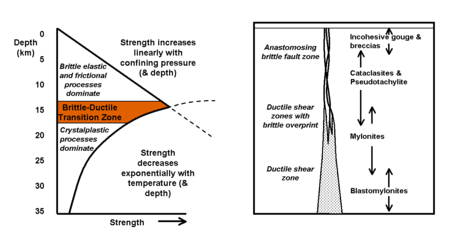Brittle–ductile transition zone
The brittle-ductile transition zone is the strongest part of the Earth's crust. For quartz and feldspar rich rocks in continental crust this occurs at an approximate depth of 13–18 km (roughly equivalent to temperatures in the range 250–400 °C). At this depth rock becomes less likely to fracture, and more likely to deform ductilely by creep. This happens because the brittle strength of a material is increased by the confining pressure, whilst the ductile strength of a material decreases with increasing temperature.

The transition zone occurs at the level in the crust where the downwards increasing brittle strength equals the upwards increasing ductile strength, giving a characteristic "saw-tooth" crustal strength profile. This zone is, therefore, the strongest part of the crust and the depth at which many earthquakes occur. The level of the transition zone depends on both strain rate and temperature gradient, being shallower for slow deformation and/or high heat flow and deeper for fast deformation and/or low heat flow. Crustal composition will also affect the depth at which this zone occurs.
Sections of fault zones once active in the transition zone, and now exposed at the surface, typically have a complex overprinting of brittle and ductile rock types. Cataclasites or pseudotachylite breccias with mylonite clasts are common, as are ductilely deformed cataclasites and pseudotachylites.[1]
See also
- Ductile Brittle Transition Temperature in materials science – Material ability to undergo significant plastic deformation before rupture
- Seismogenic layer
Further reading
- A. G. Duba (1990). The Brittle-Ductile Transition in Rocks: The Heard Volume. American Geophysical Union. ISBN 978-0-87590-025-4.
- Rolandone, F.; Bürgmann, R.; Nadeau, R. M. (2004), "The evolution of the seismic-aseismic transition during the earthquake cycle: Constraints from the time-dependent depth distribution of aftershocks", Geophysical Research Letters, 31 (23): L23610, Bibcode:2004GeoRL..3123610R, doi:10.1029/2004GL021379, S2CID 3141059